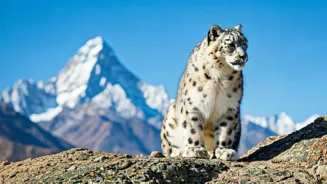Snow Leopard's Domain
The snow leopard, a majestic predator, reigns supreme in the high-altitude regions of the Himalayas. With its thick fur and powerful build, it is perfectly
adapted to survive in the harsh, cold environment. They typically reside in the rocky terrains and cliffs of the mountains, where they can easily camouflage and hunt. These solitary creatures are incredibly elusive, making sightings rare and special. Snow leopards are listed as vulnerable, and conservation efforts are essential to protect their shrinking habitat and the prey species upon which they depend. Understanding the habitat preferences, along with their movement patterns, has helped conservationists to develop effective preservation strategies to make sure the snow leopards keep thriving in the Himalaya region.
The Red Panda's Charm
Known for its reddish-brown fur and bushy tail, the red panda is another captivating animal found in the Himalayas. These arboreal animals live in the forests, where they spend much of their time in trees. They primarily feed on bamboo, supplemented by fruits, insects, and eggs. Red pandas are smaller than giant pandas and are known for their playful nature. They are well-adapted to the cold temperatures with their thick fur and are known for their unique way of life. Their population is threatened by habitat loss and poaching, so conservation initiatives are crucial for their survival. The red panda's existence is a symbol of ecological balance, so protecting their habitat will ensure they survive well in the Himalayan region.
Blue Sheep's Grace
The blue sheep, also known as the bharal, is a key species in the Himalayan ecosystem. They live in high-altitude, open terrains and are well-adapted to the thin air. These animals are named for their bluish-gray coats. They are known for their agility and ability to navigate steep slopes with ease. The blue sheep are a primary food source for predators such as the snow leopard. They are social creatures, living in herds, which helps them to ward off predators and share resources. These creatures play a major part in the ecosystem by being the prey for predators and keep the balance in their habitat. Threats to their population include habitat degradation and hunting, highlighting the significance of conservation measures.
Himalayan Monal's Beauty
The Himalayan monal, a colorful pheasant, is one of the most striking birds of the Himalayas. The male monal has iridescent plumage with a range of colors, from green and blue to red and gold. They dwell in the forests and rocky slopes and like to forage for seeds, insects, and plants. Himalayan monals have a unique ability to adapt to high altitudes. Their presence is an indicator of a healthy Himalayan ecosystem. Habitat loss and hunting pose risks to their population, underscoring the need for preservation efforts. The vibrant beauty and adaptability of the Himalayan monal make them a symbol of the biodiversity of the region and the importance of preserving their habitat.
The Tibetan Wolf
The Tibetan wolf, a subspecies of the gray wolf, is well-suited to the harsh conditions of the Tibetan Plateau and the Himalayas. They have dense fur to withstand the cold temperatures, and their diet consists of wild ungulates like blue sheep and marmots. These wolves often live in packs, and their social structure is complex. They play an important role in maintaining the ecological balance in the high-altitude regions by regulating prey populations. Conservation efforts are necessary to protect their habitat and prevent human-wildlife conflicts. The Tibetan wolf stands as a testament to the ability of species to survive in the most challenging of environments.
Musk Deer's Scent
The musk deer is known for the musk it produces, highly valued in traditional medicine and perfumes. Found in the Himalayas, these deer dwell in forested and shrub-covered areas. They are solitary creatures, primarily feeding on plants and lichens. The male musk deer have prominent tusks, which are used for display and fighting. Their population has been severely impacted by poaching, and they are now listed as an endangered species. Conservation efforts are focused on protecting their habitat and regulating poaching. Their unique scent glands and lifestyle make them a symbol of the rich biodiversity of the Himalayas and the importance of safeguarding their habitat.
The Himalayan Tahr
The Himalayan tahr is a large, wild goat that inhabits the steep, rocky slopes of the Himalayas. With their thick, reddish-brown coats and large horns, they are well-adapted to the mountainous terrain. They are mostly herbivores, and they feed on grass and other vegetation found in their habitat. The Himalayan tahr is known for its agility, climbing ability, and ability to survive in the challenging environment of the high mountains. While they are not currently endangered, their habitat and population face threats from habitat loss and hunting, making conservation measures vital to maintain their existence and their natural environment.
The Brown Bear
The Himalayan brown bear, a subspecies of the brown bear, is one of the largest predators in the region. They have a thick coat of fur to protect them from the cold. They live in forests and alpine meadows, where they feed on a varied diet of plants, insects, and small animals. These bears are known for their ability to hibernate during the winter months. The Himalayan brown bear is an endangered species, threatened by habitat loss, poaching, and human-wildlife conflicts. Conservation efforts are crucial to protecting their habitat and ensuring the survival of this significant species. Their existence signifies the richness of the Himalayan ecosystems.
The Ibex's Resilience
The ibex, a wild goat species, is known for its impressive, curved horns. They are adapted to living in rugged, mountainous terrains. They can climb and move through difficult areas. Ibex primarily feed on grasses and other plants, and they have adapted to the harsh climate. The males compete during mating season, demonstrating their strength and agility. These animals play an integral role in the Himalayan ecosystem. Conservation efforts have to protect their habitat. The ibex represents the ability to adapt and thrive in the Himalayas.
The Black-Necked Crane
The black-necked crane is the only crane species found in the Himalayas and Tibet. They are easily recognized by their black necks and white bodies. These cranes migrate to the high-altitude wetlands and valleys to breed. They feed on various foods. The black-necked cranes are considered sacred in some cultures, and their presence is a symbol of the purity of the Himalayas. They are threatened by habitat loss and human disturbance. Conservation efforts are in place to protect their habitat, ensuring their survival. Their existence is a reminder of the delicate balance of the Himalayan ecosystem.


